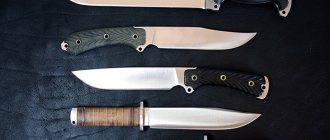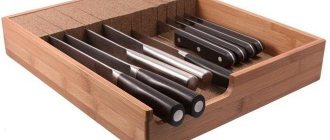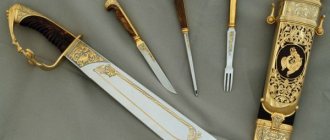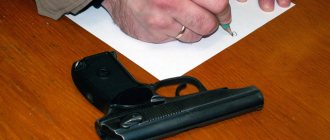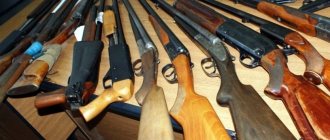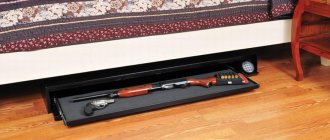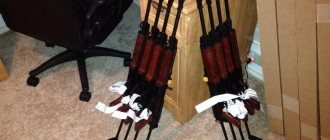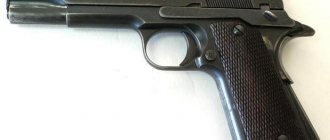The greatest and most significant invention of mankind is a rather simple and today everyday thing, it is neither a wheel nor a microprocessor with computers. And the most common one is a knife. There is no need to be cunning, without this tool, a person simply would not survive. And today, its use has become commonplace, and we do not notice it. But it’s one thing to use it in the kitchen, and another thing – can you carry a knife with you? Let's try to understand this sensitive issue.
Medium size knife.
Definition according to the law of the Russian Federation, characteristics, criteria, permissible knife blade length
A bladed weapon is any product related to the hunting, sports or military sphere. At the same time, their action is in no way related to energy carriers and explosives, however, when used, these products can cause a serious injury to a person or cause death.
Article 1 of Federal Law-150 gives a slightly different definition . Thus, the law establishes that edged weapons are a product used to hit a target in close contact with it using muscular force (physical impact).
This type of weapon includes a variety of knives, daggers, sabers and brass knuckles, stilettos and much more. At the same time, the law does not include various household and household appliances, in particular kitchen, garden and pocket knives, in the category of edged weapons.
In accordance with Russian legal principles, edged weapons have the following characteristic features:
- you need special limiters (without them it is difficult to plunge the knife into the target deeply enough and safely for the person wielding it);
- the blade length is over 9 centimeters, it is from this size that the knife can begin to be considered a real weapon; ⇐
- blade thickness – from 0.24 cm;
- the angle of contact of the blade with the butt is less than 70 degrees;
- bending deviation – 0.9 cm;
- characteristics of the minimum hardness of the metal (steel) – 25 Rockwell;
- the depth of penetration of the blade when hitting a target is more than 2 cm. The most striking example here is the checker.
Knife handle
This is a fairly broad requirement. First of all, the handle should ensure the owner’s safety from injury when using the knife, that is, eliminate the possibility of the hand slipping onto the blade during a strong stabbing blow. To do this, there are either stops or finger grooves on the handle of the knife. The length of the one-sided stop (limiter), or the total length of the two-sided one, should not be less than 5 mm. The same applies to the depth of the finger groove, if it is present alone on the handle. If there are several such recesses, then the depth of each of them should not be less than 4 mm. Accordingly, if a knife has a simple handle, without stops or recesses, it cannot provide adequate safety for the hand and will not be a bladed weapon.
The above requirements are valid only for those stops and guards that are formed by a separate transverse plate and represent an independent structural element. However, there are handles where the stops are formed by the so-called heel of the blade, that is, the same metal that forms the blade itself. This is often found on slip-mount knives, where the handle and blade are made from one solid piece, with pads on the sides for easy grip. In this case, the length of the supports for edged weapons is still 5 mm, but the thickness of the metal outgrowths themselves should not be less than 3.5 mm to ensure comfort and safety of holding.
Do I need a permit, who has the right to carry
The following categories of citizens have the right to carry bladed weapons by law:
- law enforcement officers on duty;
- citizens whose activities are related to hunting;
- athletes for whom owning a weapon is a professional duty;
- retired military personnel who use edged weapons that have trophy status;
- citizens attending thematic cultural events dedicated to weapons (selling antiques);
- users accompanying various cargo during transportation and transportation as a self-defense item.
A permit for bladed weapons will be required in a situation where it does not fall under the category of “civilian use.” If a particular knife has parameters indicating that it belongs to a real weapon, the owner will need to obtain special permission.
Prohibited knives in Russia
FZ-150 establishes a number of functional prohibitions regarding weapons.
The following types of weapons that could be used for civilian and official purposes and are classified as high-risk products are strictly prohibited for circulation:
- stun guns with increased power;
- brass knuckles;
- firearms that imitate the shape of other objects;
- armor-piercing cartridges.
Regarding bladed weapons, the list of prohibited items is much smaller. Thus, knives with automatic opening, as well as objects with a blade length of more than 90 mm, are completely prohibited for free circulation.
Also prohibited are weapons of a throwing nature (surikens, boomerangs), and objects with shock-crushing action.
Is brass knuckles considered a bladed weapon in Russia?
According to the current provisions of the Russian legislative framework, brass knuckles are classified as a special category of edged weapons that have a shock-crushing effect.
Such items are prohibited for sale and carrying on the territory of the Russian Federation, and violators will face criminal liability! Especially severe punishment threatens those for whom the use of brass knuckles is in the order of things.
General information
The law on carrying and storing edged weapons was adopted by the State Duma on November 13, 1996. It was last amended on March 7, 2022. Federal Law 150 contains 32 articles. This law controls and regulates legal relations arising when carrying and storing any type of weapon on the territory of Russia. It also regulates and defines measures and processes for the protection of citizens, civil and state property, measures and processes for the safety of the population, nature and natural resources. Federal Law 150 ensures the development of weapons intended for use in various sports, determines the processes of international relations in the fight against crime and the illegal distribution and storage of all categories of weapons.
Summary of Federal Law No. 150 on weapons:
- 1 tbsp. – a list of concepts and terms used in the law and their definitions is given;
- 2 tbsp. – various types and categories of weapons are listed and described;
- 3 tbsp. – information about weapons that can be used by citizens of the Russian Federation has been compiled;
- 4 tbsp. – information about weapons that can be used by government employees and officials has been compiled;
- 5 tbsp. – information on the use of categories of weapons defined as hand-held cold and hand-held small arms has been compiled;
- 6 tbsp. – describes the prohibitions and restrictions established by law on the storage and use of weapons;
- 7 tbsp. – a list of conditions and requirements for weapons and ammunition is presented;
- 8 tbsp. – information on entering information into the state register has been prepared. a register of equipment and ammunition used by the population;
- 9 tbsp. – describes the process and methods of obtaining a license to purchase and collect weapons and ammunition;
- 10 tbsp. – a list of persons entitled to arms is given;
- 11th century – a list of rights, powers and guarantees of state rights is given. military organizations for armament;
- 12 tbsp. – a list of rights, powers and guarantees of rights to purchase and use legal weapons is given. persons with special permission;
- 13th century – a list of rights and guarantees of rights to the acquisition and storage of equipment by citizens of the Russian Federation is given;
- 14th century – the processes and nuances of the acquisition, import and export of weapons to the territory of the Russian Federation by foreigners have been formalized;
- 15th century – other categories of persons who have the rights to purchase the described objects are listed;
- 16th century – the process and legal side of the production of equipment and ammunition has been formalized;
- 17th century – the processes and nuances of the import and export of weapons and ammunition into the territory of the Russian Federation have been formalized;
- 18th century – trade in various types of weapons on Russian territory is described;
- 19th century – describes the process and nuances of the sale or transfer of equipment by citizens to various military state companies;
- 20 tbsp. – the purchase and sale, inheritance, donation of weapons and ammunition have been formalized;
- 21 Art. – the process of resale of weapons belonging to citizens to other persons has been formalized;
- 22 art. – the nuances and basic provisions for storing equipment and ammunition as personal property are described;
- 23 Art. – the amount of the fee and the method of payment for the use of the described legal objects are presented. persons;
- 24 Art. – a list of situations is given when citizens have the right to use equipment;
- 25 Art. – information is provided on the registration, transfer, transportation, wearing in everyday life and in service, collecting, destruction, etc. of existing weapons;
- 26 Art. – cancellation of the license and seizure of the described objects;
- 27 art. – seizure of equipment and ammunition;
- 28 Art. – state control over trade and circulation of weapons in the country;
- 29 Art. – date and period of entry into force of this Federal Law;
- 30 tbsp. – registration of other laws, acts and regulations to comply with the described law;
- Art. 31 – programs used by government. employees to comply with the requirements of the law;
- 32 Art. – invalidation of certain articles and provisions of the law.
The latest changes to the Federal Law on Trade in the Russian Federation can be found here:
The legal definition of a bladed weapon is a weapon designed to be used, using human musculature and strength, to kill a subject by direct contact with him.
There are different types of equipment, the categories are divided into piercing, cutting and chopping. These include knives, daggers, stilettos, checkers, brass knuckles, swords, broadswords, dirks, etc. Kitchen, penknives and garden knives have a complex system and large blades, but are not considered edged weapons.
On average, a dangerous edged weapon has the following list of characteristics:
- The length of the blade is more than nine centimeters;
- A finger stop is installed when holding equipment;
- The blade thickness is more than 0.24 cm;
- The weapon penetrates the target to a depth of more than 2 centimeters;
- The angle between the butt and the blade of the object does not exceed 70 degrees;
- According to the established standard, the hardness of steel is at least 25 Rockwell;
- When measuring transverse bending, minimum 0.9 cm.
According to the parameters listed above, the permissible length of a knife blade by law is less than nine centimeters. If the buyer cannot accurately determine the length of the blade and whether the purchased weapon meets the acceptable standard, the person can contact specialists from the forensic department to clarify the characteristics of the object.
What kind of knife can you carry with you in Russia according to the law, without permission?
The law allows you to carry a bladed weapon whose blade length does not exceed 9 cm. If situations arise where it is necessary to verify the involvement of the weapon owner in a crime, a special examination will be carried out.
At what age can you carry edged weapons?
Federal legislation establishes certain temporary restrictions on the free carrying of weapons. So, if an item has household or economic use, you can wear it from any age.
True, you cannot take it with you to public places, airports, public areas with a large number of people, parades and other cultural events. Although, in the event of problematic issues involving minors, responsibility rests with the parents (guardians).
As for items that fall into the category of edged weapons, they can be worn after reaching the age of 18 and with a licensed license.
Pros and cons
So, are “cold” knives the most adequate option when choosing? Certainly not. The best knives that we can choose for ourselves will almost never be like this. The main criterion here is not only the scope of tasks, but also legal restrictions on the carrying and circulation of bladed weapons. If household knives have no restrictions on use and purchase, then in the case of edged weapons you should be careful. But then, secondly, we determine what the knife will be used for. And here sometimes compromises are impossible. For example, what knives should perform the function of finishing off an animal during a hunt leaves us with no choice but to turn to extremely effective edged weapons. And some restrictions on its free carrying or acquisition should not repel us, but once again remind us that handling weapons implies responsibility.
How to obtain permission (license) to store and carry
To obtain permission to store and carry weapons, you will need to contact the police department at the citizen’s place of residence. You will need to write a corresponding application and attach a copy of your passport data and 2 passport-type photographs. The applicant must meet only one requirement - to be an adult.
After checking the application, the Department of Internal Affairs makes a decision to issue a license and carries out a procedure such as registration.
The validity period of the permit is 5 years, and upon completion the user is required to get rid of the dangerous item or renew the document.
How to buy a hunting knife legally
For citizens wishing to purchase a hunting knife (a weapon prohibited for the general public), there is a mandatory requirement to register a dangerous item and obtain the appropriate permit from the state.
Using a hunting knife without a permit is a violation and is punishable according to the applicable state requirements.
Hunting knife permit
The law classifies hunting knives as high-risk items. Obtaining a license for a hunting knife is accompanied by submitting an application to the police department at your place of residence and providing an identity card and personal passport-style photographs. The validity period of the permit is 5 years. During this period, the user has the right to buy and store a knife.
If we are talking about a hunting knife, you will also need a hunting association membership card. The knife is assigned a unique personalized number, which is displayed on the ticket. In addition, a detailed description of the weapon is given here.
How to wear and store correctly
The legislator does not establish special rules regarding the storage of edged weapons. It is recommended to keep the dangerous item in a special protective case and store it in a locked place at home, preferably in a safe.
As for wearing, there are even fewer requirements. With a license, the user can legally carry any bladed weapon. An exception would be situations when he visits closed security facilities, airports, public events (parades, concerts, etc.).
Legal aspect
Here the main role is not played by which knife is considered a bladed weapon and which is not. Moreover, in this aspect it may not even be a knife at all, since the legal interpretation of edged weapons only presupposes the capacity in which a particular item was used. And if the item was used as a weapon, then in the eyes of the law it will be such. This aspect concerns one specific subject within one specific action. And since a variety of objects can be used as edged weapons, understanding this interpretation is very important.
Collecting edged weapons in the Russian Federation and its features
Collecting weapons involves their acquisition and subsequent storage or sale . In our country there is a provision (Article 10 of Federal Law-150) according to which an appropriate state license will be required to exhibit collectible weapons.
It is also worth noting that it is strictly prohibited to collect prohibited types of weapons according to GOST standards (throwing blades, shurikens, impact weapons, brass knuckles, stabbing objects), as well as those products whose dimensions exceed the legal requirements (blade more than 90 mm).
Machete
Despite their terrifying appearance, machetes, of course, are not melee weapons. Firstly, they do not have a pronounced point; secondly, the thickness of the blade does not provide rigidity and safety when piercing - often it does not exceed two millimeters. And even the ability to deliver the most dangerous cutting blows does not make such blades a weapon, since, according to legal requirements, edged weapons are intended primarily for piercing, and only then for all other tasks. According to GOST requirements, the blade length for such products starts from 175 mm and, like hunting cleavers, reaches half a meter.
Responsibility for illegal storage, carrying or manufacturing
Regarding violations related to the storage, carrying and production of bladed weapons, the law provides for both administrative and criminal sanctions.
Administrative punishment will be determined, and permissible liability will appear in the form of:
- a fine of 500-5000 rubles (depending on what signs of the offense are identified);
- removal of a dangerous item;
- The administrative code allows for a thorough investigation into the circumstances of the receipt of weapons, as well as their possible involvement in criminal acts.
The punishment under the Criminal Code is much stricter:
- compulsory work for 480 hours;
- correctional labor for 2 years;
- restriction of freedom for 2 years;
- imprisonment for 2 years;
- a fine in the amount of 50-80 thousand rubles or in the form of income for 6 months.
It must be established that illegal purchase of a prohibited product is also punishable.
Latest changes in the law
Amendments to federal legislation on bladed weapons are carried out regularly. The legislator is constantly tightening the requirements for owners of dangerous items.
Among the latest changes affecting Federal Law-150 are:
- Citizens caught poaching will lose their licenses for permitted weapons and will be expelled from the hunting community.
- Users who have more than 2 protocols for non-payment of fines for traffic violations within a year will lose their license and face the confiscation of a dangerous item.
- The possibility of revoking permission for citizens in debt is being discussed. What kind of debt exactly is not yet indicated.
Arbitrage practice
Example 1. Citizen A was detained by law enforcement officers with a knife belonging to the “edged weapon” category.
In accordance with the Administrative Code, citizen A was fined 500 rubles, and in addition, a dangerous item was confiscated. Subsequently, the knife will be sold and the amount transferred to the owner.
Example 2. Law enforcement officers detected an attempt to manufacture bladed weapons in artisanal conditions. In addition, a sample of illegal weapons that he had previously manufactured was seized from the suspect.
Criminal proceedings have been opened against the violator, and he was awarded a fine of 50 thousand rubles. Since the offender is the sole breadwinner of the family, a sanction in the form of compulsory work for 480 hours was taken against him.
Example 3. A citizen in the city was detained by law enforcement officers with a knife of unknown origin. The dangerous item was confiscated and the offender was fined. The citizen challenged the actions of the police and insisted on conducting an examination, which should determine the parameters of the product, criteria, etc. The result of a thorough study is that the knife belongs to the category of household use. The citizen was returned his property, and he will have to get back the money paid as a fine. Administrative prosecution has been completely stopped.
